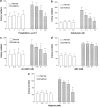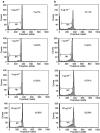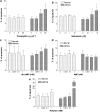Effect of theophylline and specific phosphodiesterase IV inhibition on proliferation and apoptosis of progenitor cells in bronchial asthma
- PMID: 12684271
- PMCID: PMC1573747
- DOI: 10.1038/sj.bjp.0705131
Effect of theophylline and specific phosphodiesterase IV inhibition on proliferation and apoptosis of progenitor cells in bronchial asthma
Abstract
1. Theophylline possesses anti-inflammatory activities in asthma. We examined whether theophylline and agents that modulate cyclic AMP can determine the survival and proliferation of progenitor cells. 2. Progenitor cells from the blood of normal and asthmatic subjects were cultured for 14 days in methylcellulose with GM-CSF, stem cell factor, IL-3 and IL-5. Apoptosis was measured by flow cytometry of propidium-iodide-stained cells. 3. A greater number of colonies with a higher proportion of cells of eosinophil lineage from asthmatics compared to normal subjects were grown. Theophylline (at 5 and 20 micro g ml(-1)) significantly inhibited colony formation and increased apoptotic cells in asthmatics compared to control. Salbutamol (0.1, 1, 10 micro M), dibutyryl-cAMP (0.1, 1 mM) and rolipram (0.1, 1 mM), a phosphodiesterase IV inhibitor, also dose-dependently decreased colony numbers and increased apoptosis of progenitor cells from asthmatics. 4. There was no significant effect of theophylline, db-cAMP, salbutamol or rolipram on colony formation or the survival of progenitor cells from normal subjects. AMP did not affect the colony formation and apoptosis. Expression of Bcl-2 protein on progenitor cells of asthma was downregulated by theophylline, salbutamol, db-cAMP and rolipram. 5. Theophylline and rolipram decreased colony formation committed to the eosinophil lineage, together with an increase in apoptosis through an inhibition of Bcl-2 expression effects that may occur through cAMP. The anti-inflammatory properties of theophylline include an inhibition of circulating progenitor cells.
Figures





References
-
- ADACHI T., MOTOJIMA S., HIRATA A., FUKUDA T., KIHARA N., KOSAKU A., OHTAKE H., MAKINO S. Eosinophil apoptosis caused by theophylline, glucorticoids, and macrolides after stimulation with IL-5. J. Allergy Clin. Immunol. 1996;98:S207–S215. - PubMed
-
- CHAO D.T., KORSMEYER S.J. Bcl-2 family: regulators of cell death. Annu. Rev. Immunol. 1998;16:395–419. - PubMed
-
- CHOU C.L., WANG C.H., KUO H.P. Upregulation of IL-5 receptor expression on bone marrow-derived CD34+ cells from patients with asthma. Chang Gung Med. J. 1999;22:416–422. - PubMed
-
- CHUNG K.F. Theophylline in chronic asthma: evidence for disease-modifying properties. Clin. Exp. Allergy. 1996;26:22–27. - PubMed
-
- CROCKER I.C., TOWNLEY R.G., KHAN N.M. Phosphodiesterase inhibitors suppress proliferation of peripheral blood mononuclear cells and interleukin-4 and interleukin-5 secretion by human T-helper type-2 cells. Immunopharmacology. 1996;31:223–235. - PubMed
Publication types
MeSH terms
Substances
LinkOut - more resources
Full Text Sources
Medical
Miscellaneous

